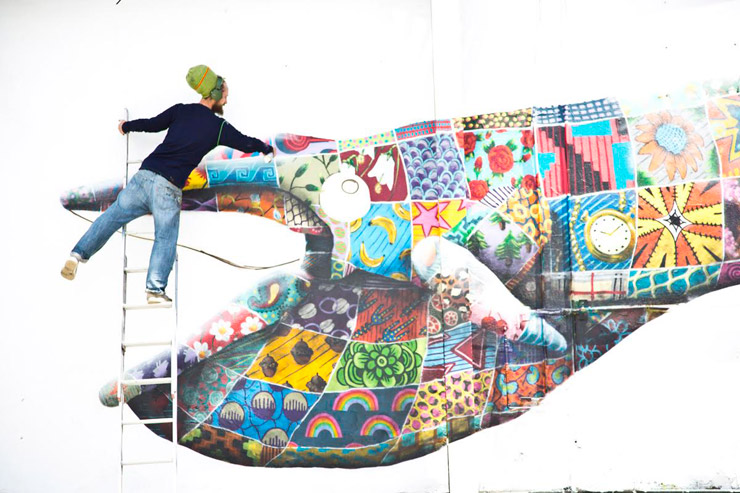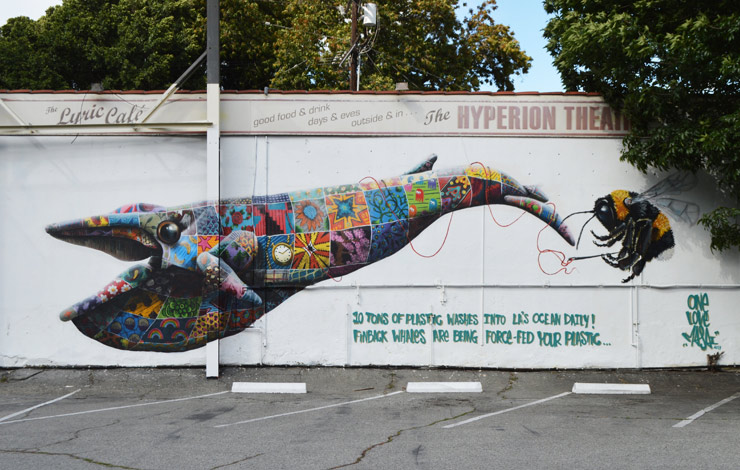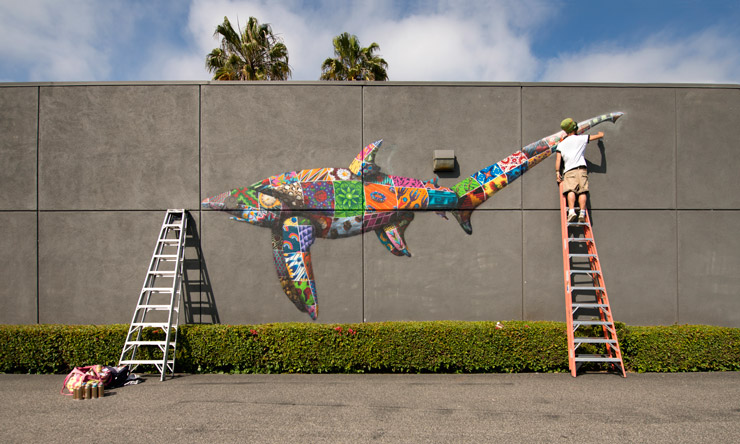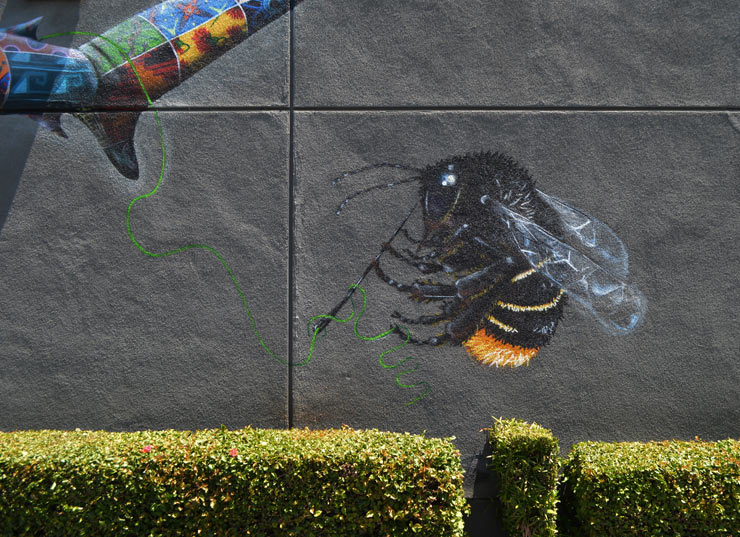These Animals Are Eating All the Plastic You are Throwing Away. Yuck.
London Street Artist Louis Masai has just returned to the US to do three murals – one in alliance with the Right Whale Research Association (R.W.R.A) in Cape Cod Massachusetts, and two in Los Angeles where he is currently having a solo show at C.A.V.E. gallery entitled “The Sixth Extinction”.

Louis Masai. Right Whale. Cape Cod, MA. (photo © Lisa Sette)
With his work intrinsically tied to environmentalism and disappearing species, Masai told us at great length about a few people and organizations he worked with when making these new pieces. He also educated us about the DIRECT relationship that you and we have with killing off species and causing their suffering by using plastics. Here are a few excerpts from our conversation to better appreciate the work that Louis is doing right now.
“Cape Cod attracts a continuous flow of summertime tourists to its quaint villages of seafood shacks, lighthouses, beaches and whale watching excursions,” Louis says. “Its economy however, is steeped in a controversial whale hunting history of blood.” He worked with Lisa Sette from R.W.R.A. to create this new mural in the town. He also shared some of Lisa’s statements about the project here:

Louis Masai. Right Whale. Cape Cod, MA. (photo © Lisa Sette)
“I feel like a lot of us in the US are feeling isolated due to the current political climate. What better way to bring the community together than through a mural that highlights the most critically endangered large whale in the Northwest Atlantic that happens to spend winter and spring in our waters. The mural is bringing people together and allowing for conversations to begin – unexpected conversations.”
Lisa Sette continues, “Of course when in company of biologists, advocates and real life eco-warriors, it’s impossible to not become even more inspired by the impacts that a species like the right whale faces. The North Atlantic right whale is a baleen whale, they are listed as a rapidly decreasing, critically endangered species, with only a few over 500 left. Baleen whales feed on zooplankton and krill; they take large gulps of water and then filter out their tiny prey using baleen plates. During feeding season, usually from spring to fall, right whales may eat more than 2,600 pounds of zooplankton per day, and of course today that also includes a huge amount of plastics.”

Louis Masai. Right Whale. Cape Cod, MA. (photo © Louis Masai)
Laura Ludwig, of the Center for Coastal Studies, often gives presentations about plastics in the environment.
“Once you’ve seen the images of whales’ stomachs packed solid with plastic bags; or of albatrosses who’ve died after ingesting a diet of nothing but bottle caps; or of an osprey chick who entangled itself in a balloon string used as nesting material — once you’ve seen familiar plastic items as the instrument of death for innocent animals, the path reveals itself.”
100% of the ocean is now infected with plastic, says Laura. What can WE do to try and help rectify this issue? These are Laura’s top three tips.
-
Over 300,000,000 straws are used every day in the US alone: swear off plastic straws and bring your own metal, glass or rubber straw if you like to use them.
-
BYORB: there are over 5 trillion plastic bags used every year around the world — 160,000 per second, if you break it down per capita. Bring Your Own Reusable Bag and refuse thin film plastic bags.
-
Bottle water is a scam: over 50 billion bottles of water are sold in the US alone annually, and only 20% of them are “recycled”. Stop buying water in plastic bottles — BYOB, again!

Louis Masai. Right Whale. Cape Cod, MA. (photo © Louis Masai)
Louis tells us that when in Cape Cod he took one of those famous whale-watching trips. To say he was excited is an understatement. He also may be exagerating a little.
“It literally blew my eyes out of their sockets – I saw Right Whales, Fin Back Whales, Sei Whales, Humpback Whales, and Dolphins too. Naturally, he made like-minded friends there and caught up with Charles Mayo better known as Stormy, the director of the Right Whale Ecology Program, who told him how big whales also get caught up in plastic nets and other crap we throw away – trapped!
We don’t have space here to recount a rescue mission he did with a whale named Ibis, we can will tell you this part of the story. “After several hours Ibis tired from dragging floats and stopped swimming. It was only then that we were able to cut the nets and ropes from around her. We had freed her,” says Charles. “This rescue mission evolved to us creating specialized tools and a system for freeing entangled whales and we still use floats, buoys and boats to slow the whales to this day.”

Louis Masai. Right Whale. Cape Cod, MA. (photo © Lisa Sette)
It may seem obvious, but the real solution is for you and us to stop throwing this crap away to begin with. It doesn’t magically disappear.
Louis says that he learned that rescuers “are only able to save about 50% of entangled right whales, and 80% of humpbacks, the majority of them are struggling out at sea and never reported to the rescue team. Rescuing them is only a stopgap measure and the real work needs to be done in stopping them getting entangled in the first place.”

Louis Masai. Right Whale. Cape Cod, MA. (photo © Louis Masai)
“I hope that my mural will raise some thoughts amongst the thousands of tourists visiting Cape Cod. Perhaps they might even think twice about using the straws, plastic bags and water bottles still available in Cape Cod.”
When he got to L.A. for his show ‘Sixth Extinction’ with C.A.V.E Gallery he painted a finback whale, which is a visitor to the waters of L.A, “Another baleen whale suffering the same punishment of plastics in the ocean. I read that a ridiculous 10 metric tones of plastic enter the L.A Ocean per day, which is comparative to more than the weight of a London bus. The result of this painting was a challenge to the owner of the wall, “The Lyric Hyperion’. They are now on a route towards eliminating the use of plastics in their service.”

Louis Masai. Finback Whale. Silver Lake, CA. (photo © Ari Sturm)
Louis’ last painting for this trip was of a big-eyed Thresher shark, another ocean species that is suffering an apparent decline in population in Californian waters. In addition to a vulnerable life-history characteristic, these sharks are suffering from a continued fishing pressure from pelagic fleets which has the species listed as vulnerable.
“Most of the species I highlight, if not all, are in danger of their lives due to evidential climate change, I’m back in London now and realizing that my trips to and from the states have many, many more endangered species to lift a light for.”
This means we still have a lot to learn from the art of Louis Masai.

Louis Masai. Finback Whale. Silver Lake, CA. (photo © Louis Masai)

Louis Masai. Finback Whale. Silver Lake, CA. (photo © Louis Masai)

Louis Masai. Thresher Shark. Venice, CA. (photo © Lmnotree)

Louis Masai. Thresher Shark. Venice, CA. (photo © Lmnotree)

Louis Masai. Thresher Shark. Venice, CA. (photo © Louis Masai)

Louis Masai. Thresher Shark. Venice, CA. (photo © Lmnotree)
For more information on Louis Masai’s show “The Sixth Extinction” at C.A.V.E. Gallery, please click HERE:
Other Articles You May Like from BSA:
We were just looking at this piece by graffiti writer and mixed media artist Greg Lamarche aka Sp.One, and we were reflecting that art-making and advocating for social/political change can be a one-...
Welcome to BSA Images of the Week! The New Year has been good so far, except if your country is in a war and is being pulverized. We captured some exceptional street art during our visit...
Our weekly focus on the moving image and art in the streets. And other oddities. Now screening : 1. Shepard Fairey's Wall in Little Italy 2. ARYZ for CityLeaks 3. Robots Spraying Ou...
Tor (@toris64) picked us up at the airport using his hand-made faux-Banksy Nuart sign, wearing his fresh Dismaland t-shirt, and we immediately knew we were home here in Stavanger. Born and raised in...
Street Artist and renaissance man Gaia tried his hand at developing his mural for the Grove Street Neighborhood in Gainesville, Florida in Virtual Reality recently and we have few new shots to prove i...
 BROOKLYN STREET ART LOVES YOU MORE EVERY DAY
BROOKLYN STREET ART LOVES YOU MORE EVERY DAY










